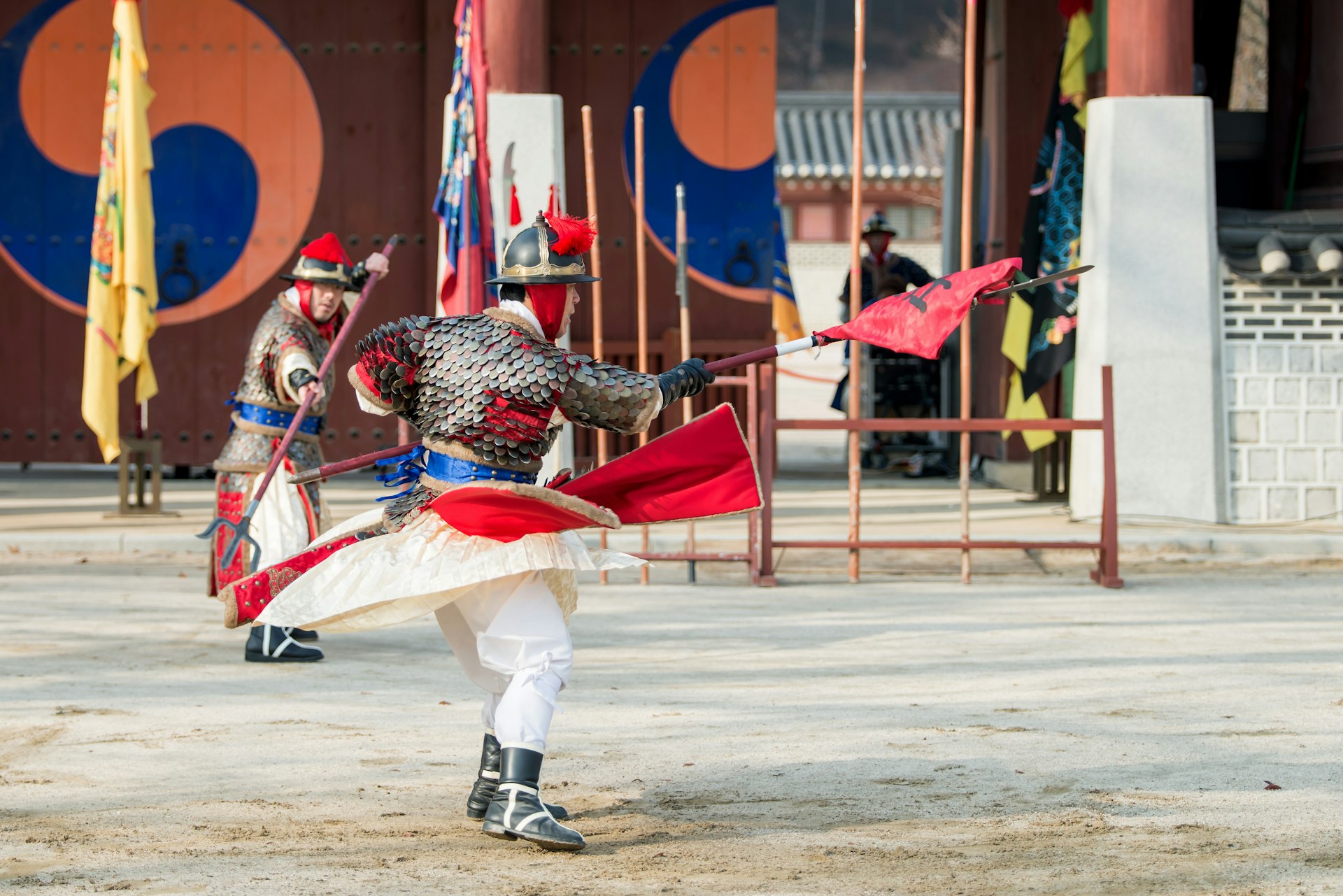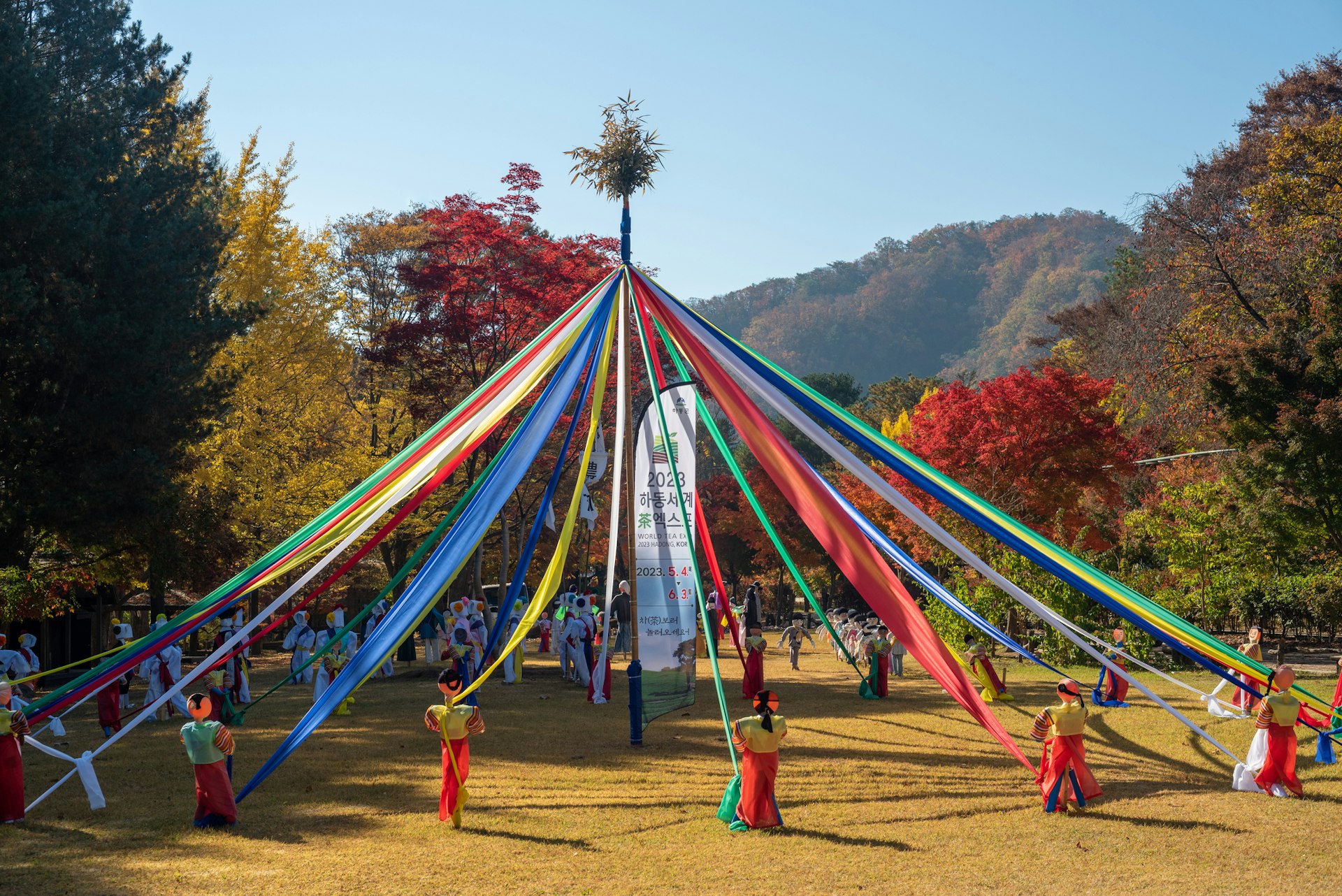So, you’re done with dynamic Seoul?
You’re finished with its top fashion. You’re through with its cutting-edge technology. You can’t listen to another K-pop beat.
Well, you’re in luck. Less than two hours away from the capital’s ancient palaces and timeless temples are some super day trips. From learning about Joseon history to visiting the DMZ, the demilitarized zone between North and South Korea, these are our favorites.
1. The Demilitarized Zone (DMZ)
Sitting between Seoul and North Korea, Paju is the closest city to the Demilitarized Zone (DMZ) that divides the Korean peninsula. At Panmunjom and the Joint Security Area (JSA), North and South Korean soldiers face each other across the military demarcation line. The atmosphere is noticeably tense at this historically significant spot, where important events such as the signing of the Korean Armistice Agreement took place.
Since the end of the Korean War in 1953, authorities have uncovered four unfinished tunnels that North Korea built into South Korea. Three are now accessible to visitors on guided tours. The third tunnel is particularly popular and slightly unnerving because of its proximity to Seoul – it finishes just 52km (32 miles) away from the capital. Located 7km (4 miles) from the military demarcation line, Imjingak park acts as a gesture of hope for unification. Built in 1972, it has many relics from the war on display, including tanks and a destroyed train.
If you join a DMZ tour, you’ll be able to visit the Dora Observatory, which offers clear views of North Korea, including the city of Kaesong and the settlement of Gijeong-dong. The nickname of the latter, “propaganda village,” comes from claims that the pristine-appearing settlement is actually uninhabited, except for a handful of caretakers who occasionally flick lights on and off to simulate signs of life. Many believe it exists simply to encourage South Koreans to defect for a “better life” across the border.
Near the observatory is Dorasan Station, the northernmost station on South Korea’s rail network. To visit the DMZ (including Panmunjom and infiltration tunnels), you must join an official guided tour with an accompanying military escort, but you can visit Imjingak independently.
How to get to the DMZ from Seoul: Paju is 33km (20 miles) northwest of Seoul, and it’s easily accessible by train from Yongsan Station, with a journey time of one hour. Buses also run to Paju from Seoul’s northwestern districts.

2. Suwon
The capital and largest city of Seoul’s surrounding Gyeonggi Province, Suwon is a popular day trip for its historic and cultural heritage sites. The vast Hwaseong Fortress has walls that stretch for over 5.5km (3.5 miles) with four main gates, including Janganmun, the largest gateway in Korea. With scenic views and a rich history, this UNESCO World Heritage site is a must-visit.
Hidden within the fortress walls are Haenggung Palace and the royal residential quarters. They were once used by royalty as a temporary home while traveling on royal business. Though the Japanese colonial occupation destroyed much of the site, restorers have largely rebuilt it, offering a fascinating window into past royal life.
Feeling hungry? Suwon is famous for its beef, and the local galbi (marinated ribs) are a must-try for carnivores. Kabojung is one of the best spots to sample galbi – the government has recognized the owner as a Korean Food Grand Master. Close to Suwon City Hall station, Yuchi Hwoegwan serves up a celebrated haejangguk (hangover stew), chock full of beef, cabbage, scallions and more. This nutrient-rich soup is perfect after a big night out.
How to get to Suwon: Suwon is 31km (19 miles) south of Seoul. Trains run regularly between Seoul’s Yongsan Station and Suwon Station, and the journey takes just under one hour.

3. Ganghwa-do
About 50km (31 miles) northwest of Seoul, Ganghwa-do is technically a part of Incheon City, and as Korea’s fourth-largest island, this scenic spot offers plenty to see. It has also served as the setting for many of Korea’s most important historical events.
In the southern part of the island. Jeondeung-sa has the distinction of being Korea’s oldest Buddhist temple, dating back to 381 CE. The temple grounds sit within the ancient Samnang Fortress, and the scenic surroundings present picture-perfect views in all seasons. Those interested in a more immersive experience can sign up for a Templestay program.
It’s a moderate hike up some steep steps to reach the summit of 469m (1538ft) Mani-san, Ganghwa-do’s highest peak, but the surrounding views are memorable. At the top is a sacred altar called Chamseongdan that Dangun, the legendary founder of Korea, is said to have used. Another sacred spot on the island is the pretty Jeokseok-sa Buddhist temple on the western side of Mt Goryeo-san.
If all that hilltop hiking wears you out, head to the Toga restaurant in the village of Heungwang-ri (close to the slopes of Mani-san) for a hearty bowl of tofu and salted shrimp stew, made with the island’s famous tiny shrimp. The homemade tofu comes in a milky white broth that’s only lightly seasoned by the shrimp but still deep in flavor.
How to get to Ganghwa-do: Ganghwa-do is about 50km (31 miles) northwest of Seoul. Buses run from Seoul’s Hapjeong Station in the west of the city to Ganghwa Terminal in just under two hours.

4. Chuncheon
The capital of Gangwon Province, Chuncheon – with its surrounding rivers and hills – is a top destination for nature lovers and outdoor activity enthusiasts. Namiseom Island in the Bukhan River has become famed for its majestic trees and scenic views. It also has cafes, tourist shops, a small museum and a gallery, and you can explore on foot or rent a bike. To reach the island, catch the ferry, or take the zip wire if you’re feeling adventurous.
In summer, Chuncheon and the surrounding regions are great places to try water sports such as waterskiing, kayaking and rafting. There are various water sports centers along the Bukhan River. Korea’s largest artificial lake, Soyang Lake, is popular for its scenic trails and pretty roads; you can also travel to several towns across the lake by ferry.
When it comes to food, Chuncheon has an entire alley of restaurants dedicated to dakgalbi, a popular dish of chicken marinated in a gochujang-based (red pepper paste) sauce and cooked with vegetables in a big pan. You can eat the stir-fried chicken in lettuce wraps or on its own.
How to get to Chuncheon: Chuncheon is 75km (46 miles) northeast of Seoul and is accessible by direct bus from Seoul’s Dong Seoul Terminal in a little over an hour, or by train from Cheongnyangni Station in just under two hours.

5. Busan
Despite its location on the opposite side of the country, travelers can reach the coastal town of Busan from Seoul in 2 hours and 15 minutes by train. It makes for a fantastic (though somewhat long) day trip or – better still, a more leisurely weekend break from the capital.
Mountains, a scenic coastline, great street food and a cosmopolitan vibe make Busan, the country’s second-largest metropolis, one of South Korea’s most enjoyable cities to hang out in. Its top attraction is the atmospheric, waterside Jagalchi Fish Market, where you can buy and eat some of Korea’s freshest seafood.
Other highlights include the glorious golden sands of Haeundae Beach and the Busan Cinema Center, an architecturally dazzling structure with the biggest outdoor screen in the country. We also recommend strolling the lanes of Gamcheon Culture Village, sampling the local bingsu (flavored shaved ice), and knocking back shots of potent soju (Korea’s favorite spirit) in a tent bar.
How to get to Busan: Busan is on the southeastern coast of South Korea, 325km (202 miles) away from Seoul. Direct high-speed trains run from Seoul to Busan, connecting the two cities in as little as two and a half hours.
